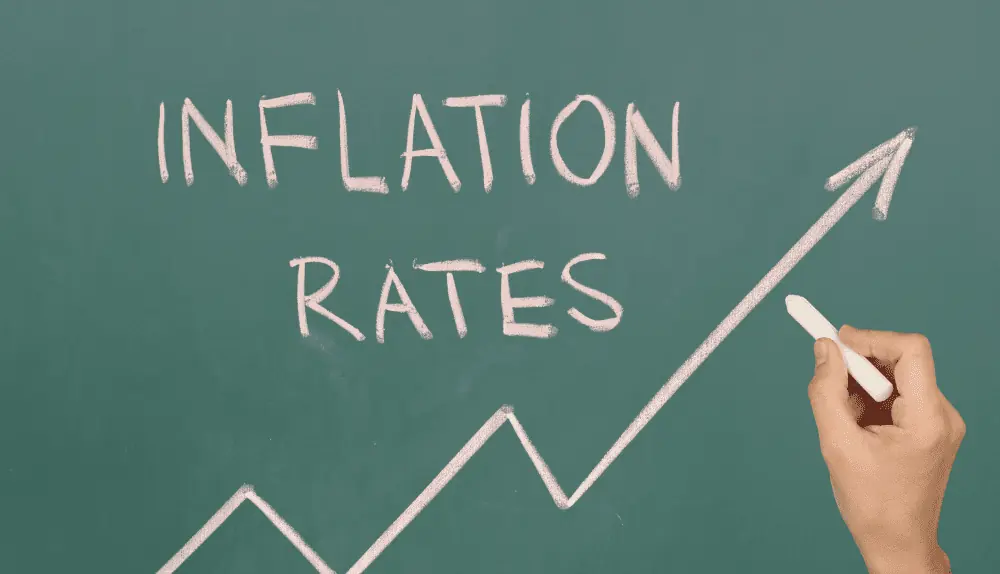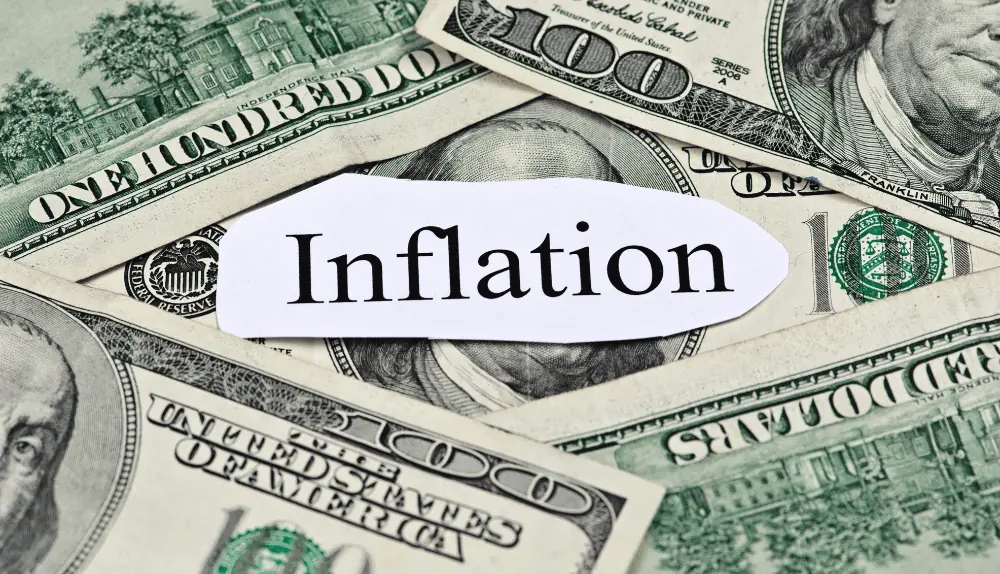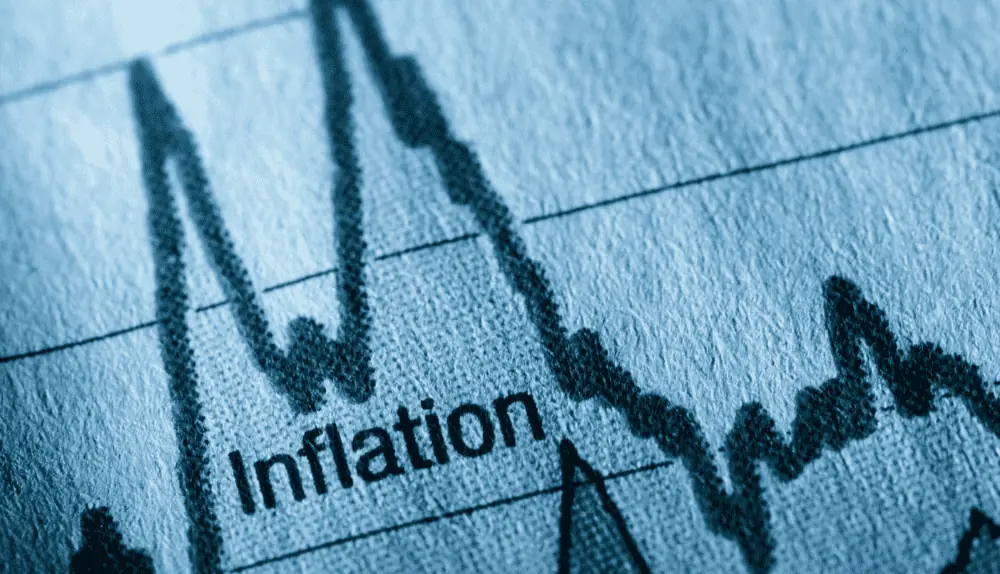Inflation refers to the increase in prices of goods and services over time. This results in decreased purchasing power of money and a reduction in the value of currencies. It is usually measured by the rate of change in a country’s Consumer Price Index (CPI). Inflation can be caused by several factors including changes in supply and demand, increases in production costs, and changes in government policies. It is important to understand inflation and its causes as it can greatly impact an economy, investments, and individuals’ financial well-being.
Definition of Inflation
Inflation refers to a general rise in the prices of goods and services over a period of time. It means your money buys less than it used to. Inflation reduces the value of currency over time.
There are several metrics used to measure the rate of inflation in an economy. The most common metric is the consumer price index or CPI. It tracks the average change in prices over time of a basket of goods and services that are representative of the spending patterns of the average consumer. A high and persistent CPI suggests high and worrisome levels of inflation.
Moderate and stable inflation is typically considered normal and even healthy for an economy. However, very high or volatile inflation can lead to economic issues like:
Reduced standard of living. When the cost of living increases continuously, people have to spend more of their income on essential items. They have less left to spend on other things like entertainment, hobbies, or luxury goods.
Impaired economic growth. High inflation discourages people from investing in businesses and property as the financial returns from such investments may get eroded by inflation. This limits investment, productivity, and job creation.
Increased inequality. Poor and middle-class people who have fixed incomes like salaries, pensions, or wages may not get adequate increases to fully offset higher prices. This can worsen inequality in society.
Economic instability. Unstable high inflation is difficult to predict and plan for. It introduces uncertainty which is harmful to businesses, investors, workers, and governments. They can’t make sound financial decisions when inflation is volatile.
Rate of Inflation

The rate of inflation refers to the speed or percentage increase in prices over a given time period. Policymakers closely monitor the inflation rate as it determines how much the overall cost of living increases year after year.
Moderate stable inflation of 2% or less per year is typically considered healthy for economic growth while high inflation poses serious problems. Most economists argue that an inflation rate in this range is ideal as it ensures steady price-based growth without eroding the value of money or reducing living standards.
When inflation rises above 5-10% per year, it leads to economic difficulties and social malaise. High inflation rates have damaging consequences like:
•Eroding purchasing power. As prices spike upward at a fast pace, the value of money declines rapidly. Your income and savings can buy fewer goods and services over time.
•Unstable environment. Rapidly changing prices create more uncertainty for businesses, investors, workers, and consumers. It becomes harder to accurately assess costs, set wages, determine prices, and make sound financial decisions. This discourages spending, risk-taking, and productive investment.
•Increased cost of living. People have to spend a larger portion of their income on essential items when costs rise quickly. This leaves less money for other priorities like education, healthcare, travel, or retirement savings.
•Wage-price spiral. As workers demand higher pay to offset higher living costs, companies raise prices further to account for increased costs. This can lead to an inflationary cycle of accelerating spending and price pressures that are difficult to break.
•Inequality effects. Poor and middle-income groups suffer the consequences of high inflation the most as their incomes often fail to keep up with rising costs. Wealthier households with more substantial financial means typically fare better.
•Higher interest rates. Central banks increase interest rates significantly to try and tame high inflation. But higher interest rates slow down borrowing, purchasing, and business investment overall. This can weaken economic growth.
Types of Inflation

There are several types of inflation categorized based on their causes and characteristics. The main types are demand-pull inflation, cost-push inflation, imported inflation, and deflation.
Demand-pull inflation occurs when aggregate demand in an economy outpaces aggregate supply. It means there is too much money chasing too few goods. As demand for goods and services rises faster than production, companies respond by raising prices. This feeds into higher costs and prices across the economy. Demand-pull inflation reduces purchasing power over time.
Cost-push inflation is caused by rising production costs, especially higher wages and increasing raw material prices. Businesses pass on these higher costs to consumers in the form of higher product prices. While demand-pull inflation is based on too much demand, cost-push inflation roots in rising supply costs. Both ultimately lead to a general increase in price levels.
Imported inflation refers to higher inflation brought about by rising import prices. When imported goods become more expensive due to increasing price pressures in other economies, domestic companies also raise their prices and costs of production. This accelerates inflation. Imported inflation is tied to global economic imbalances and rising costs in other markets.
Deflation refers to a general decline in the overall price level. It means stable or falling prices over a period of time. While benign in moderate degrees, severe or prolonged deflation can be extremely harmful. When prices drop rapidly, they undermine consumption, business profits, and economic activity. Deflation also raises the real burden of debt since money repaid back has greater purchasing power. This contributes to recession, unemployment, and financial crises.
Each type of inflation has impacts on economic growth, income distribution, financial stability, and standard of living. Moderate stable inflation is normal in most economies but high or volatile inflation of any form should be avoided. Controlling inflation ultimately requires addressing its underlying causes whether rising demand, costs, imports, or the threat of deflation. The goal is price stability that supports prosperity rather than hinders it.
Causes of Inflation
- Increased demand in an economy
Increased demand refers to higher spending by consumers, businesses, the government, or net exports in an economy. When demand for goods, services, labor, investment, and economic activity accelerates rapidly, it can exert upward pressure on prices. This is known as demand-pull inflation.
there are a few reasons why demand may rise and potentially lead to demand-pull inflation:
•Consumption boom. Households may increase spending on things like retail goods, vacations, home purchases, or entertainment due to income growth, easy access to credit, or low-interest rates. Strong consumption growth fuels demand and can push up inflation.
•Investment surge. Businesses may decide to expand by building new plants, equipment, or technology. Rapid investment in new productive capacity also adds demand and can drive prices upward.
•Government spending spike. The government may approve large spending bills for programs like infrastructure, stimulus, wars, or entitlements. Higher government spending works like increased consumption and investment to boost demand and inflation.
•Import boom. A country may import more goods due to increased demand and consumption. Relying on imports means domestic producers have more room to raise prices. As import prices rise, inflation also increases.
• International competitiveness loss. Wage growth and price pressures may account for a large portion of cost increases. But if there is no corresponding productivity improvement, companies lose competitiveness on the global stage. They have to raise prices just to maintain profit margins, causing demand-pull inflation.
- Increased costs of production
Rising costs of production refer to higher expenses incurred by businesses in producing goods and services. Increased costs can lead to cost-push inflation where companies pass on higher prices to consumers. There are a few factors that can contribute to rising production costs:
• Higher wages: If wages increase significantly due to minimum wage hikes, union demands, or labor scarcity, businesses have to pay more for the same labor inputs. They incorporate higher wages into higher costs and prices.
• More expensive raw materials: The prices of key materials and commodities can rise due to supply shortages, increased demand, geopolitical issues, or currency fluctuations. Businesses deal with higher costs by charging customers more.
• Greater regulatory burden: Stricter government regulations like environmental policies, worker protections, product standards or healthcare mandates may increase costs of compliance for companies. Higher costs are reflected in the retail prices of goods and services.
• Reduced productivity: If productivity growth stalls while costs continue rising, companies lose efficiency and profit margins fall. To restore profitability, they raise the prices of products to offset lower productivity and higher costs.
• Technology obsolescence: Frequent technological changes can lead to faster obsolescence of equipment, materials, and systems. Companies have to invest heavily in new technologies and platforms to stay competitive, forcing costs and prices upward.
- Imported inflation
Imported inflation refers to higher prices and costs in an economy that result from increasing inflation in other markets and jurisdictions. When businesses have to pay more for imported goods and inputs due to rising prices abroad, they pass on these higher costs to domestic consumers in the form of increased product prices. This contributes to accelerating inflation overall.
There are a few ways imported inflation can impact a national economy:
•Rising import prices: If the cost of goods imported from other countries rises due to inflation in export markets, importers raise the prices of those goods for sale in the domestic market. This makes imported products more expensive for consumers and fuels inflation.
•Higher costs of imported inputs: Many businesses rely on imported raw materials, components, and intermediate goods as inputs into their production processes. When the prices of these imports rise significantly, companies face higher costs of producing their goods. They increase the prices of final products to offset input price inflation, feeding into overall inflation.
•Currency depreciation: Sometimes, imported inflation is the result of a weakening currency relative to other currencies. As a currency depreciates, the domestic cost of imports rises automatically. Importers then raise prices to account for the higher costs, and inflation spreads through the broader economy.
•International price spillovers: Inflation that originates in major economies with large global influence like the United States can spill over into smaller open economies through trade channels. When there is high inflation in large export markets, it leads to rising import and input prices that fuel inflation domestically.
Impact of Inflation
- Positive impact
Moderate inflation does have some benefits for an economy. When prices rise over time, the cost of goods and wages also tend to increase. This allows people and businesses to afford more with the same amount of money.
Inflationary pressures actually stimulate demand in an economy as people spend more of their income on goods and services. This boosts overall economic activity and can encourage businesses to increase production to meet the growing demand. Higher production, in turn, leads companies to hire more workers which lowers unemployment rates.
Stable and predictable inflation also makes economic planning easier for businesses, investors, and individuals. They can factor in average price increases when determining budgets, setting salaries, investing for the future, or taking out loans. Moderate inflation diminishes the value of debt over time, making it easier to repay loans and interest charges.
While high inflation is problematic, moderate inflationary gains in the 2-3% range provide some benefits. They keep an economy dynamic and growing while allowing stability. Policymakers aim for this kind of stable, predictable inflation rate that maximizes the benefits of inflationary pressures without causing significant hardship. Such moderate inflation is seen as a sign of a healthy, growing economy.
- Negative impact
While moderate inflation provides some benefits, high or unpredictable inflation has significant economic costs. When prices rise too quickly, the value of money falls substantially. This can lead to a decline in purchasing power as incomes have to stretch further to afford goods and services.
Rapid price increases strain household and business budgets, creating financial hardship. This is especially difficult for those on fixed incomes like the elderly. Inflation can lead to higher costs for essential items like food, transportation, and housing which people have little choice but to continue purchasing.
High inflation creates economic uncertainty which discourages investment. When the future value of money is uncertain, businesses and individuals become more reluctant to invest in assets like equipment, property, or education. This can slow economic growth in the long run.
Unstable inflation also makes planning more difficult for businesses, workers, and lenders. When prices rise unpredictably, it’s hard to determine appropriate wage increases, set financial goals, or establish fair interest rates. This inefficiency reduces productivity and distorts the overall economy.
Chronic high inflation can trigger a recession as rising costs force people to cut back on spending. As demand falls, companies see declines in revenue and may lay off workers or shut down. This spiral of high inflation and weak growth is hard to escape without policy adjustments.
Outside of a few temporary gains, the negative impacts of rapid price increases including higher costs of living, financial hardship, reduced investment and economic uncertainty far outweigh any benefits of inflation. Public support for anti-inflation policies comes from people’s experiences with the costly effects of high inflation.
- Measures to control inflation
To control high inflation and promote stable prices, governments, and central banks use several policy tools. The most common measures include:
Tightening the money supply. A central bank can increase interest rates and reduce the growth of the money supply. Higher interest rates make it more expensive for banks to lend money, which slows down spending and investing in the economy. A smaller money supply also limits the cash available for transactions.
Increasing interest rates. The central bank may raise the benchmark interest rate directly to discourage borrowing and make saving more attractive. This reduces demand in the overall economy.
Raising reserve requirements. The central bank can require commercial banks to hold a larger percentage of deposits in reserve rather than lending them out. This reduces the amount of money available for loans and spending.
Implementing price controls. Setting maximum price limits, wage controls, or profit margins aims to directly reduce inflationary pressures. However, price controls often lead to unintended consequences like shortages as they distort the normal supply and demand relationships in an economy. They are rarely used today.
Tightening fiscal policy. The government can cut spending, increase taxes or run a smaller budget deficit. This reduces the total amount of money in circulation, decreasing demand and bringing inflation back to stable levels. Spending cuts and tax hikes have a direct impact on household incomes and purchasing power.
A combination of these policies is frequently used to combat high inflation. Policymakers adjust interest rates and the money supply as buffers against shocks like oil supply crises. The tight fiscal policy provides further support to get inflation under control without stifling economic growth. The goal is to reduce inflationary pressures gradually through prudence rather than radical change. With consistency, these policies aim to build credibility that anti-inflation efforts will persist until price stability is achieved.

